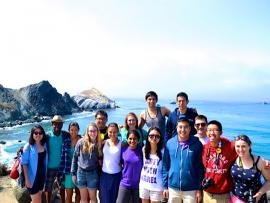Student Affairs
Get to Know Us

So, let us introduce you to Residential Education (ResEd) from a student’s perspective.
Let’s say you are a freshmen living in Soto House (located within Wilbur Hall on East campus). As a frosh, you might interact with the Resident Assistant, (RA) who lives on your floor. You might know that this RA works with other RAs and other house team members, for instance a PHE or an RCC within your residence hall, apartment or house. You might also know your house's Resident Fellows, (RFs). These are Stanford Faculty and Staff who live on-campus and guide the house community throughout the course of the academic year.
You might also realize that this structure exists in many other houses across the campus. It is likely you won't venture too far beyond getting to know your own house team, but most other houses have a similar structure to your own. In one complex alone, like Wilbur, you'll find 8 house staff teams—each unique in their approach to the community.
At some point, you might wonder what it's like to live in another part of campus. A Row house like Xanadu has a different team structure than a residence like Soto. It doesn't have RFs, but instead it has student managers and occasionally will have staff members with specialized roles who serve that house's community. Some of these roles are the PHE, Theme Associate, or Co-Op Manager. This team structure can be found throughout the Row, though again each house will have its own unique approach and culture.
Taken together, these two structures represent many of our residences across the campus. House teams are a core component of ResEd, since they have the most contact with residents.
ResEd is also made up of professional staff members, who don't generally live on campus, but who have frequent contact with residents. For example, Program Associates (PAs) work closely with Resident Fellows and Student Staff in the development of programs, while Residence Deans (RDs) generally manage cases involving individual students in a house.
While each of the RDs and PAs are responsible for particular houses, they are also part of a larger team dedicated to the three regions of campus; East, West, and Row. These teams also consist of Area Administrators, Program Managers, Assistant Deans, and an Associate Dean who leads each of the area teams.
There's also a central office for ResEd, which is home to Dean Golder! To give you a sense of scale - Dean Golder is 1 of 7 who directly reports to the Vice Provost of Student Affairs, Greg Boardman. Who is in turn, one of 28 who then directly report to the Provost, John Etchemendy, who in turn is one of 17 who then directly reports to the President of the University, John Hennessey.

The central office is also where our financial team and the central office administrative team work to facilitate all of the various financial needs from the houses and departmental initiatives, as well cross campus administrative needs. They work directly with the area teams to ensure houses are able to bring all of their creativity and passion to life thoughtfully.
You're probably thinking - we've gotten pretty far from our individual student, but, in truth, the University is designed with the individual student in mind. In fact, in 1968 the university came together to articulate a vision for its future - the Study of Education at Stanford. This report, in no uncertain terms, upheld the importance of the individual student and continues to influence the mission of the university today.
First, it asserted that an education could not be limited by hours or years - that it could not be confined to time spent in the classroom. This paved the way for the many out-of-classroom opportunities students currently enjoy and which ResEd helps to facilitate.
The University held that Stanford's academic, intellectual, and educational interests were at stake within the residences, as well as within the classrooms and that the University should whole-heartedly accept the responsibility to provide within the residences an environment that was supportive of the individual student, supportive in the development of their identity, supportive in the process of becoming a well-educated person, and supportive of the full integration of the individual student's education with all aspects of their personality. This was the beginning of what was subsequently called, Residential Education.
ResEd is about making Stanford feel smaller and aspires to provide a 'world class, out-of-class experience'. We're the ones that make it possible for every frosh to be greeted by name from the moment they arrive on campus. We're also the ones who catch students when they stumble and help them find their path back to success. In other words ResEd is about students and finding the best ways to support their individual residential experience.


